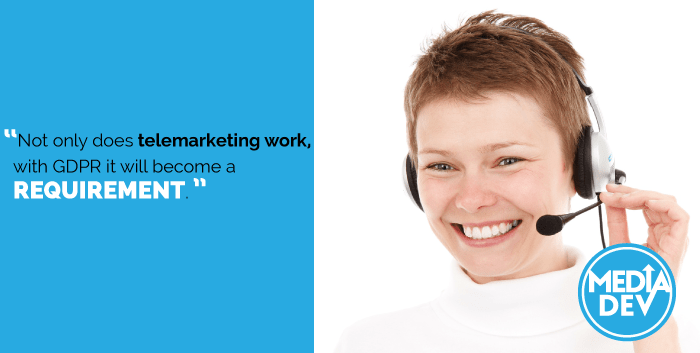For some reason when I sat down to write Part 3 of this Why Telemarketing Still Works series (for those of you that missed Part 1 and Part 2, feel free to read them too!), I thought of pan-handling. I know it’s a strange association to make, but desperate telemarketers cold-calling prospects can almost be equated to begging at times (when it’s done wrong). In recent years, the abundance of low-quality telemarketing calls has pushed many companies to steer away from outbound tactics in order to drive sales, preferring online (email) marketing strategies instead.
However, with the General Data Protection Regulation (GDPR) in the EU coming into the spotlight now as the countdown to compliance is running down to the wire, companies are going to have to revert back to telemarketing after all. Cleaning data lists and obtaining (“unambiguous” or “explicit”) consent will be a requirement, since blindly emailing someone that has not requested to be contacted will expose companies to monumental fines of up to €20 million for non-compliance.
And one of the easiest ways to do this (oddly enough) is through outbound telemarketing.
How can that be?
My recent blog post entitled Why You Should NOT Buy Data from a Data Broker: How GDPR Regulations Will Affect Marketing Strategy explains the reason in a lot more detail. In a nutshell, it’s because you are allowed to call a company, speak to a contact and obtain opt-ins over the phone; then you can use the data you obtained for the specific purpose you outlined during the call. Basically, the prospect data you have now will need to be called in order to be compliant, because you are not allowed to email the contacts you have in order to be sure they agree to opt-in to receive any new information you want to send them. You can do that, or you can throw away all the data you have and start from scratch (which, let’s be realistic, is not going to happen).
I recently read another article on LinkedIn entitled The General Data Protection Regulation – Email Marketing Armageddon which exposes very clearly why it is necessary to do this since “GDPR also applies to all existing data.”
The main idea behind GDPR is transparency. Contacts need to know what data you have about them, what you are using it for exactly, where it is stored — and you have to be able to easily delete or update their data should they request that you do so. Outbound telemarketing is going to be needed in order to ensure the data you have is accurate, and that you are allowed to use the data you have for the purpose you want to use it for.
Telemarketing works if it’s done right. So how do you do it right? How can you be sure that your telemarketers are successful and not seen as annoying pan-handlers begging for sales? Here are some tips.
Don’t sell your product over the phone
Unless you are selling Nespresso coffee capsules at a highly discounted rate, it is unlikely anyone is going to buy your product outright over the phone. For more complex or technical software solutions, it’s impossible to sell without extensive evaluation anyway, so don’t even try. It’s like trying to get a job offer just by sending out your CV — it doesn’t happen. As you would use your CV to try to get a face-to-face interview, the first cold-call should be about setting the scene only. If your telemarketers come off as being too “sales-y” or pushy, it will only turn off prospects who will not opt-in to hearing more about your offers. If you’re cleansing data, it’s better to be clear about your intentions — what do you plan on emailing them, at what frequency and what type of information they will get. Of course, you will always need to give contacts the option to opt-out, so that should be explained as well. Having a straightforward, casual conversation (whose main points are outlined in a call guide for your telemarketing team prior to starting) is a great way to ensure a peer-to-peer interaction will take place. This will also set the scene for my next point.
Build trust
Engaging in relationships with prospects is the best way to build confidence in your brand over time. When smart telemarketers talk to people like people (instead of reading a script like a robot) and can show empathy, prospects will feel more at ease. If a prospect feels comfortable, he/she will be more likely to open up during the conversation. Of course, it takes time to establish trust, but it also takes the right type of telemarketer to get the job done. Telemarketers who can think on their feet, counter-argue, explain key benefits and position solutions using a soft approach will be more effective than those who stumble over themselves and rush to get to the end of their script. Couple good phoning practices with effective emails and you have a recipe for success.
Listen closely
Any two-way conversation requires talking and listening. And to be frank, listening is the more important of the two if you ask me. Most people like to talk about themselves, and behavioral psychologists confirm that people’s feelings about how a conversation went are more positive the more they feel the other person was listening. Good listening skills also contribute to a natural and interactive conversation; you should not just be waiting for the other person to stop talking in order to ask the next question on your list, but rather listen to what the prospect has to say so as to ask the next most appropriate (follow-up) inquiry. You will find that conversations will improve ten-fold the more attentively you listen.
Outsource to the experts
If you don’t feel that you have what it takes to tackle telemarketing outreach on your own, then don’t. Effective outsourcing can be the best way to tap into the skill set you need, which may include native language coverage you don’t currently have in-house. There’s no shame in using a marketing agency to help you; good ones should be able to give you strategic counsel to help make your outreach program a success.
Once you’ve obtained an opt-in, don’t abuse it
When a prospect has opted-in to receiving emails, don’t start sending them messages every five minutes. People receive an overwhelming number of messages daily, and they’ll only ignore them (or are pushed to opt-out) if you send too many. Same goes for calling. You don’t want prospects to feel like they are being harassed, so you can’t call them 500 times a day. If you have multiple contacts per company that you need to speak to, you’re going to have to space them out over a certain interval; otherwise, the gatekeeper is going to recognize you are calling (again) and will block you before you even get the chance to speak to the decision-maker.





